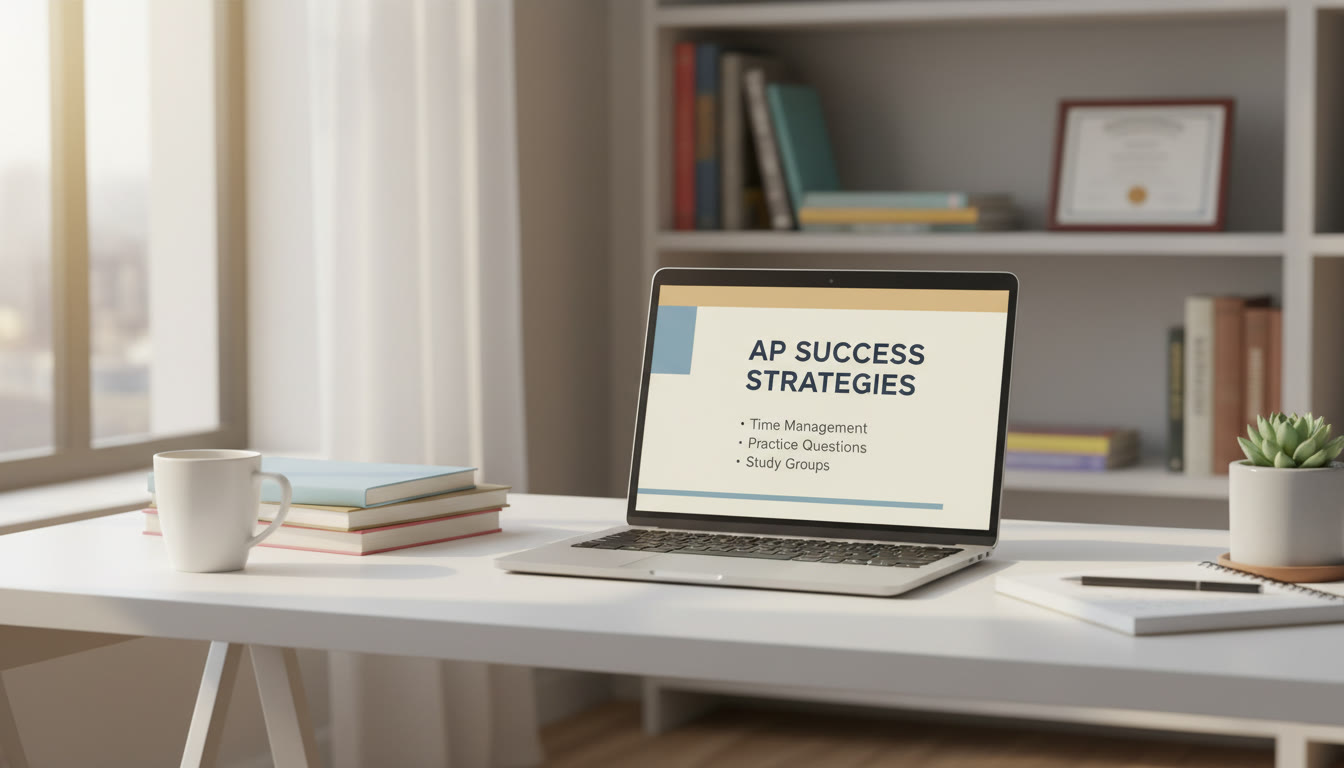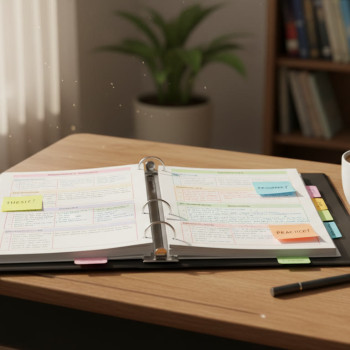Why Slide Design Matters for AP Students
When you’re preparing an AP presentation, whether it’s for a research project, an oral exam, or a classroom review, your slides are more than just a backdrop — they’re a powerful communication tool. Great slides make complicated ideas feel simple. Bad slides make even brilliant ideas disappear under a storm of tiny text, clashing colors, and irrelevant images.
This guide will walk you through the essentials of minimalist, readable, and effective slide design: what to keep, what to toss, how to use space and typography, and practical templates you can adapt. Along the way, you’ll find examples and small experiments you can run while studying. If you want individualized help turning these ideas into a polished presentation, Sparkl’s personalized tutoring can provide 1-on-1 guidance, tailored study plans, and expert feedback to level up your slide skills quickly.
The Minimalist Mindset: Less Is the New More
Minimalist design isn’t about being boring. It’s about clarity. For AP students, clarity means your audience — classmates, teachers, or exam readers — should be able to grasp your main points in seconds. Minimalism reduces cognitive load: fewer elements, clearer hierarchy, and more whitespace.
Core principles of minimalist slide design
- One idea per slide: If you can’t summarize the slide’s message in a 6–8 word headline, split it.
- Hierarchy: Headline, subhead, supporting bullet — design each with a distinct size and weight.
- Whitespace: Let your content breathe. Crowded slides feel heavy and are hard to read.
- Limited color palette: Use 2–3 colors: a neutral background, one text color, one accent color.
- Consistent typography: Stick to 1–2 typefaces; use bold and size for emphasis, not many fonts.

Readability: Make Every Word Count
Good design supports readability. Your choice of type, contrast, and spacing determines whether your audience actually reads your slide.
Typeface and size
For presentations, choose legible sans-serif fonts for body text (e.g., Helvetica, Arial, or similar) and a slightly bolder choice for headings. Practical size guide:
- Headline: 36–44 pt
- Subhead: 24–32 pt
- Body text: 18–24 pt
These ranges are a starting point — adjust depending on the room, screen size, or whether the slides will be viewed on a laptop or phone.
Contrast and color
High contrast is non-negotiable. Dark text on a light background or light text on a dark background works best. Avoid color combinations that cause vibration (e.g., bright red text on bright blue). Use the accent color sparingly — for callouts, data highlights, or to draw attention to a quote.
Line length, spacing, and bullets
Keep line length moderate (about 6–10 words per line in a bulleted list). Use 1.2–1.5 line spacing and allow a comfortable gap between bullets. Resist the temptation to cram full paragraphs — slides are visual aids for your talk, not manuscripts.
Structure and Flow: How to Organize a Short AP Presentation
A well-structured slide deck helps your audience follow logic and remember main ideas. Here’s a flexible sequence you can adapt for most AP topics.
Recommended slide sequence
- Title slide — Course, topic, your name, date
- Question or thesis — One clear sentence
- Why it matters — One brief hook (1–2 bullets)
- Key evidence or points — 3–5 slides, one idea per slide
- Synthesis — How the points connect (1 slide)
- Conclusion and takeaway — One crisp sentence
- Optional: Sources or acknowledgements — Use a compact list, readable but minimal
Visual Elements: Use Images, Icons, and Data Wisely
Images and icons should support your message. When chosen carefully, a single photo or chart can communicate what a paragraph cannot.
When to use an image
- To illustrate a concept quickly (e.g., a historical photo for an AP History slide).
- To create emotional or contextual resonance for your topic.
- When the image itself is part of the evidence or analysis (like a primary source).
Keep images high quality and relevant. Cropped or pixelated photos distract more than they help.
Icons and simple graphics
Small icons next to short bullets can improve scanability, but limit icons to a consistent family and color. Use them as subtle signposts, not decorations.
Tables and charts
Data should be legible at a glance. Use tables when exact numbers matter; use charts to show trends or comparisons. Minimize gridlines and labels — emphasize the data by simplifying the surrounding design.
| Use Case | Best Visual | Design Tip |
|---|---|---|
| Comparing two items | Side-by-side bullets or a 2-column table | Use one accent color to highlight the winner |
| Showing a trend | Line chart | Remove markers if trend is smooth; keep axes labeled |
| Presenting exact figures | Simple 3–4 column table | Striped rows for readability; bold key numbers |
Design Recipes: Templates You Can Use Right Now
Here are three simple slide templates — each designed for clarity. You can copy these structures into any slide app.
Template 1 — The Evidence Slide
- Headline (One sentence) — 40 pt
- Left column: Short quote or image (40% width)
- Right column: 3 bullets summarizing the evidence (24 pt)
Template 2 — The Comparison Slide
- Headline (One question)
- Two columns with 2–3 bullets each
- Bottom: One-sentence takeaway in an accent-colored box
Template 3 — The Data Slide
- Headline: Explain what the data shows
- Centered chart or small table
- Right: Key insight or short interpretation (2–3 lines)
Common Mistakes Students Make (and How to Fix Them)
Spot these early. They’re often the difference between a so-so deck and one that genuinely supports your argument.
Overcrowded text
Fix: Edit ruthlessly. If you need to keep detailed text, move it into speaker notes or a handout.
Inconsistent styles
Fix: Use the slide master. Establish fonts, colors, and bullet styles once and apply them everywhere.
Too many animation effects
Fix: Reserve animation for emphasis only. Keep transitions simple and predictable.
Practical Exercise: Design a 6-Slide AP Mini-Deck
Try this 30–45 minute exercise to practice the principles above. Pick a short AP topic you know — an experiment in science class or a short historical case study.
Step-by-step
- Spend 5 minutes outlining your thesis and 3 supporting points.
- Create a title slide with a one-line thesis.
- Make three evidence slides, one idea each, using Template 1 or 2 above.
- Create a synthesis slide that connects the three points.
- Finish with a crisp takeaway slide.
- Time yourself presenting. Aim for 4–6 minutes total.
How to Use Speaker Notes and Handouts Effectively
Slides are visual cues; your spoken words do the heavy lifting. Keep detailed citations, statistics, and extended explanations in speaker notes or a downloadable handout. That way, viewers who want depth can access it, while your slides remain uncluttered and readable.
Accessibility: Designing Slides for Everyone
Accessibility isn’t optional — it improves clarity for all viewers. Here are quick rules:
- Use high contrast for text and background.
- Provide alt-text or image descriptions in speaker notes if your platform allows.
- Don’t rely on color alone to signal meaning (use bold, icons, or labels).
- Keep font sizes readable for people at a distance.
Comparing Styles: Minimalist vs. Decorative
Below is a quick comparison to help you decide which approach fits your purpose.
| Feature | Minimalist | Decorative |
|---|---|---|
| Best for | Academic clarity, data-driven talks | Creative projects, portfolio pieces |
| Readability | High | Variable |
| Design time | Fast after setup | Longer (more custom elements) |
| Risk | Boring if not engaging | Distracting if overdone |
Real-World Examples and Tiny Tweaks That Make a Big Difference
Small decisions add up. Here are quick, evidence-backed tweaks (based on presentation design best practices) that improve comprehension and retention:
- Use bold or color to highlight the single most important word in a bullet.
- Keep numerical comparisons in the same visual format (e.g., both as percentages or both as raw numbers).
- When quoting, present only the most relevant 10–15 words and cite the source in the notes.
Polishing Your Slides: Checklist Before You Present
- Spellcheck and read aloud to catch awkward phrasing.
- Check contrast by squinting at the screen — can you read the headline?
- Test on the device you’ll present from and on another screen if possible.
- Time your talk and remove any slides you don’t need to hit the time target.
How Tutoring Can Speed Up Your Design Mastery
If you want more hands-on help, consider targeted tutoring. Sparkl’s personalized tutoring offers 1-on-1 guidance, tailored study plans, and expert feedback that can speed up your learning curve. A tutor can review your slide deck, suggest precise design and content edits, and help you rehearse delivery — all personalized to your AP task and timeline.
Final Thoughts: Design with Purpose
Design is a tool, not an obstacle. For AP students, the goal is simple: make ideas easier to understand and remember. Keep slides minimalist, readable, and purposeful. Prioritize hierarchy, whitespace, and contrast. Use images sparingly and strategically. Test, time, and iterate — and don’t hesitate to ask for individualized feedback when you need it.

Quick Reference: A One-Page Cheat Sheet
Print or screenshot this cheat sheet before your next presentation:
- One idea per slide
- Headline 36–44 pt; body 18–24 pt
- 2–3 colors maximum; high contrast
- Use images for meaning, not decoration
- Test on real screen; time your talk
Wrap-Up
Great slides don’t happen by accident. They are the result of intentional choices that center the viewer’s understanding. Use minimalism to clarify, typography to guide, and visuals to support. If you want tailored feedback or help transforming your notes into a confident presentation, Sparkl’s personalized tutoring can provide the mentorship and AI-driven insights to make your slides shine. Now take your favorite slide and try a “less is more” edit — you’ll be surprised how much stronger your message becomes.




















No Comments
Leave a comment Cancel